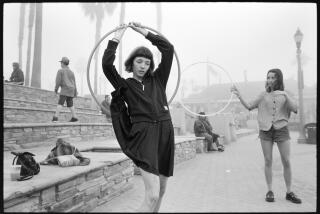Tim Burton, in his element
If, as William Carlos Williams wrote, âThe pure products of America / go crazy,â where does that leave Tim Burton, a pure product not just of America but also of Southern California, landâs end of our national phantasmagoria?
Hollywood, maybe, where Burton â born in Burbank, raised on TV and the films of Ray Harryhausen, educated at the California Institute of the Arts â landed in the late 1970s. Or London, where he now lives with the actress Helena Bonham Carter and their two kids. Really, though, the landscape Burton occupies is one of the imagination, a territory marked by whimsy and darkness, in which the visuals are the main event.
âMy background is animation,â he says by phone from his home in England. âEarly on, I was essentially a nonverbal person.â Even now, the director of âBeetle Juice,â âBatman,â âCorpse Brideâ and âEdward Scissorhandsâ seems not completely comfortable in conversation; he pauses, backtracks, like someone speaking in a second language, as he discusses âThe Art of Tim Burton,â a lavish art book featuring more than 1,000 images, some of which go back to childhood.
âThe Art of Tim Burtonâ first came out in 2009, to coincide with the opening of a Burton retrospective at New Yorkâs Museum of Modern Art. That show arrives at LACMA in May, but in the meantime, Burton has released a new limited edition of the book, with bonus material, including a signed lithograph.
The book is self-published, available from Burtonâs website. âPublishers approached me, but they didnât seem too enthusiastic,â he says, âso we decided to do it independently. That way, the whole point was the process, the joy of making it, doing it, seeing it develop. It was a more fun and positive experience.â
Burton is no stranger to books. In 1997, he published a collection of macabre fictions called âThe Melancholy Death of Oyster Boy and Other Storiesâ; he also wrote the childrenâs picture book adaptation of his stop-action animation classic â The Nightmare Before Christmas.â
More recently, he â along with writer Leah Gallo and designer Holly C. Kempf, who did much of the heavy lifting on âThe Art of Tim Burtonâ â has produced commemorative volumes for the films âSweeney Toddâ and âAlice in Wonderland,â to be given to the cast and crew. âInstead of crew jackets,â Burton says, âweâd do these books: yearbooks, personal books. So in some way, this book grew out of that.â
Thatâs a fine analogy, for âThe Art of Tim Burtonâ is as personal as a scrapbook, full of reminiscences and previously unseen work. A childhood crayon drawing of the Creature from the Black Lagoon leads to the image of an early (and unpublished) picture book called âThe Giant Zligâ and a poster Burton designed as a teenage employee of the city of Burbank for an anti-litter campaign.
There are character sketches from his movies (Jack Skellington, the Joker, Sweeney Todd) and surreal cartoons that work as visual puns. In âA Tongue Twister,â a noxious insect twists a manâs tongue so tightly that it looks like a corkscrew; âMr. Happyface remembers better daysâ presents the iconic yellow âHave a Nice Dayâ face turned in on itself, frowning over empty bottles and a half-drunk glass of wine.
Johnny Depp, Martin Landau, Winona Ryder, Pee-wee Herman and even Harryhausen all weigh in on Burton and share anecdotes. Particularly resonant is old friend Rick Heinrichsâ âShort Montage of Early Personal Impressions of Tim,â which includes this telling recollection: âPulling up to his Burbank apartment to pick him up on our way to see a film at the Cinerama Dome and observing him completely absorbed by something at ground level: the micro-world of an anthill.â
Here, we get a glimpse of Burton in his element, which is what âThe Art of Tim Burtonâ offers, as well. âItâs not showing me as a great artist,â he says. âItâs just showing my weird mental process, the way things grow. Whether Iâm working on a movie or doing a drawing, my favorite time is making it. When I finish, thereâs a nice sense of accomplishment, but really, itâs about the process for me.â
Part of that process is physical, a handâs on interaction between Burton and the work. This is why he was drawn to animation, and itâs also why he wanted to produce a book.
âI love books,â he says, âtheir tactile nature. Like stop-action animation, thereâs nothing else like them. In this age, when everyone is looking at screens, I wanted to do something different. I wanted to make a book â big, heavy, hard to hold sometimes. I wanted it to be a physical experience.â
More to Read
Sign up for our Book Club newsletter
Get the latest news, events and more from the Los Angeles Times Book Club, and help us get L.A. reading and talking.
You may occasionally receive promotional content from the Los Angeles Times.









